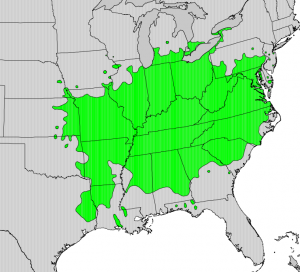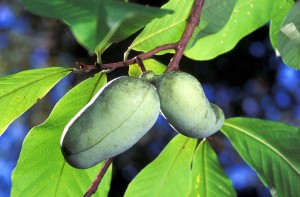Pawpaws are so cool. Ever since hearing about them last year I can’t get enough info about them. If you haven’t heard of pawpaws here is a little introduction.

The pawpaw (Asimina triloba) is a small tree native to the eastern forest region of the US. There are other species in the genus also known as pawpaws, but they are all native to the South, and some are very rare.
The pawpaw is an odd little tree- looking almost tropical. That’s because it’s the northernmost member of the Annonaceae family, which includes many tropical fruits native to Latin America, like the sweetsop and the cherimoya. Which brings us to the flavor. The pawpaw, which is the largest native North American fruit, has a distinctly tropical flavor, often described as mango and vanilla custard, or avocado with banana and papaya. The fruit is creamy and can be eaten with a spoon, and is very perishable, which is why you don’t see it in too many stores. The seeds are large and easy to remove or eat around.

The pawpaw is a perfect tree to add to edible forest gardens or to other permaculture designs. (See below for links to cultivation information) The only problem is low pollination, resulting from the fact that pawpaws evolved to be pollinated by flies and beetles, who are attracted to the decaying smell and dark red color of the pawpaw flower. These pollinators are unreliable at best, and sometimes the flowers only have a very faint smell. So, fruit set can be very low. One solution is to hang rotting meat in the branches, attracting flies and other potential pollinators. This is a gross, but fairly easy method. Another solution is to hand pollinate, which is time-consuming, but is supposed to give a very high yield.
Today I tried hand-pollination. There is a nice stand of pawpaws in the woods behind my edition that I’ve had my eye on, and that did produce a few (10 to 20) pawpaws last year. I had scoped out the trees a few weeks ago, and I figured that today would be a good day to give it a shot. I took my dog out, and off we went.
A couple things about pawpaw flowers. One is that pawpaws must be pollinated with genetically distinct pollen, so if you decide to plant pawpaws, be sure to plant two different varieties, or two seedlings, or one seedling and one named variety. The problem in the wild is that pawpaws have a tendency to produce thickets that may or may not be all clones of the same individual. But, in my target area, there were some fruits last year, so there must be some genetic diversity. I just made an effort to carry the pollen between the four or so main clumps, rather than pollinate within each clump. The other thing is that all pawpaw flowers start out as female and receptive to pollen, then they change to males and create pollen. So I had to find male flowers and carry them to female flowers in a different patch.

Things went pretty well. I just used my finger because I didn’t want to look for a paintbrush, but it worked out fine. The flowers seem to be a refuge for all sorts of spiders, ants, and beetles, some of which like to jump out at you when you try to pollinate. Ah!
The test will be whether most of the pawpaws form within my reach. Then I’ll know that my pollinations took. Until then, we wait. I’ll keep you updated.
BELATED UPDATE: The pollination seemed to work! I think. At the very least, there were more pawpaws in that stand than last year. 🙂 I’m thinking though, that one of the main limiting factors there is relative lack of sunlight- most likely fruit set would be higher with less shade.
More info:
http://en.wikipedia.org/wiki/Asimina_triloba





